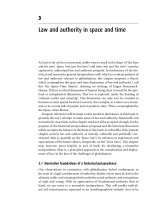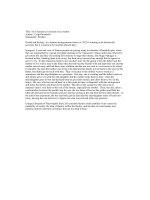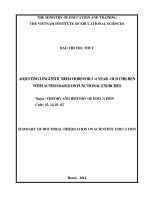3 6 objects in space (earth sciences)
Bạn đang xem bản rút gọn của tài liệu. Xem và tải ngay bản đầy đủ của tài liệu tại đây (3.97 MB, 8 trang )
Earth Sciences
Standards
Preview
4.c. Students know telescopes magnify
the appearance of some distant
objects in the sky, including the Moon
and the planets. The number of stars
that can be seen through a telescope is
dramatically greater than the number
that can be seen by the unaided eye.
Standard Set 4. Earth Sciences
4. Objects in the sky move in regular
and predictable patterns. As a basis
for understanding this concept:
4.a. Students know the patterns
of stars stay the same, although
they appear to move across the sky
nightly, and different stars can be
seen in different seasons.
4.d. Students know that Earth is one of
several planets that orbit the Sun and
that the Moon orbits Earth.
by Peggy Bresnick Kendler
Genre
Nonfiction
Comprehension Skill
Predict
Text Features
•
•
•
•
Captions
Diagrams
Labels
Glossary
Science Content
Objects in Space
Scott Foresman Science 3.6
ISBN 0-328-23533-4
ì<(sk$m)=cdfd j< +^-Ä-U-Ä-U
Vocabulary
asteroid
binoculars
orbit
planet
solar system
star
telescope
Picture Credits
Every effort has been made to secure permission and provide appropriate credit for photographic material. The
publisher deeply regrets any omission and pledges to correct errors called to its attention in subsequent editions.
Unless otherwise acknowledged, all photographs are the property of Scott Foresman, a division of Pearson Education.
Photo locators denoted as follows: Top (T), Center (C), Bottom (B), Left (L), Right (R), Background (Bkgd)
Opener ©Earth Imaging/Getty Images; 2 ©Photographer’s Choice/Getty Images; 3 Paul Oglesby; 4 JPL/NASA; 5 Paul
Oglesby; 6 (T) ©John Sanford/Photo Researchers, Inc.; 6 (B) ©Andy Crawford/DK Images; 8 Digital Vision; 9 NASA;
10 Getty Images; 11 (C)©Royal Observatory Edinburgh/SPL/Photo Researchers, Inc., (T)NASA, (B)©A. Morton/Photo
Researchers, Inc.
ISBN: 0-328-23533-4
Copyright © Pearson Education, Inc. All Rights Reserved. Printed in the United States of America.
This publication is protected by Copyright, and permission should be obtained from the publisher prior to any
prohibited reproduction, storage in a retrieval system, or transmission in any form by any means, electronic,
mechanical, photocopying, recording, or likewise. For information regarding permission(s), write to
Permissions Department, Scott Foresman, 1900 East Lake Avenue, Glenview, Illinois 60025.
3 4 5 6 7 8 9 10 11 12 V010 15 14 13 12 11 10 09 08 07
Objects
in Space
by Peggy Bresnick Kendler
What moves
around the Sun?
The Sun
The Sun is a star. A star is a huge ball of hot,
glowing gases. The Sun is 100 times as wide as
Earth. Its surface temperature is about 5,500°C. Its
center is much hotter!
The Sun is the star closest to Earth. It appears
How Objects in
the Solar System Move
Our home is planet Earth. A planet is a large
body of matter that travels around a star, such as
the Sun. Many planets have moons. Our solar
system is made up of the Sun, the planets and
their moons, and other objects orbiting the Sun.
The path an object takes as it moves around
the Sun is its orbit. The Sun’s gravity has a strong
pull. It keeps each planet in its orbit.
larger and brighter than any other star. Other stars
look smaller because they are so far away.
Earth is part of the solar system.
It orbits the Sun with the other planets.
The Sun is closer to Earth
than any other star.
Mercury
2
Venus
Earth
Mars
3
The Path of the Moon
Planets of the Solar System
Mercury, Venus, Earth, and Mars are the four
Our Moon orbits Earth. At the same time, Earth
planets nearest the Sun. They orbit the Sun quickly.
orbits the Sun. The Moon turns on its axis as it
Jupiter, Saturn, Uranus, and Neptune are the
orbits. Every 27 days the Moon completes a turn. It
planets farthest from the Sun. They orbit the Sun
completes an orbit of Earth in about the same time.
slowly. Asteroids of all sizes orbit the Sun between
We always see the same side of the Moon. This is
planets. An asteroid is a large piece of rock.
because the Moon turns so slowly on its axis.
Our Moon is the closest object to Earth. Other
Pluto, A Dwarf Planet
Pluto is very small, smaller than Earth’s moon.
In 2006, scientists decided to call Pluto a “dwarf
planet.” Dwarf planets are small, round objects
than the Sun it is the brightest object in the sky.
The Moon does not make light. Its light comes
from sunlight reflecting off its surface.
that orbit the Sun.
The Moon completes its orbit
in a little less than a month.
Charon
Pluto
4
NASA’s Hubble Space
Telescope was used
to take this picture of
Pluto and its moon,
Charon.
5
How do we observe
objects in space?
Telescopes and the Night Sky
To see the Moon more clearly, look through a
telescope. A telescope is a tool for making distant
objects appear nearer and larger. Some telescopes
use curved mirrors. The mirrors collect light. The
light travels to a lens. Telescopes that use these
mirrors help make objects appear bright in the
night sky.
A telescope makes the
Moon look larger. It
can help you see the
Moon’s features.
6
Binoculars are two telescopes joined together
as a unit. They are less powerful than telescopes.
Binoculars and telescopes work best on clear
nights, far from city lights.
Before you look at the night sky, study charts of
the stars and planets. Next, observe the sky with
your eyes. Then try binoculars or a telescope.
Planets look like stars. They shine by light
reflected from the Sun. Planets move across the
sky’s star patterns.
Binoculars are like
telescopes. But they
are not as powerful.
7
Viewing Distant Planets
Binoculars and telescopes can help you study
the solar system’s planets. Use binoculars to see
Mars’s red surface. Use a telescope to see the band
of clouds above Jupiter’s surface. Jupiter’s Giant
Some planets are very far away from Earth.
They are too far away for people to see them
clearly. These planets are Uranus and Neptune.
The United States has sent space probes to study
these planets.
Red Spot can also be spotted with a telescope. It is a
storm three times the size of Earth!
This picture shows Mars’s
red soil. The white dot at
the top is a polar ice cap.
Neptune has a light
blue color. It is
surrounded by rings.
Have you ever heard of the
Giant Red Spot? It is a huge
storm on Jupiter’s surface.
8
9
Viewing Stars and Galaxies
On a clear night, you can see many stars. With
Different Kinds of Stars
The Sun is our brightest star because it is closest
a telescope, you can see even more stars. Stars look
to Earth. Does this mean that bright stars are
different from one another. Some look brighter
closer to Earth than ones that are less bright? This
than others. Some look larger than others. And
is not always so. Stars differ in size. Stars differ in
some appear to have a different color than others.
the amount of light they make. Many small stars
A star might really be a galaxy. A galaxy is a group
make more light than big stars. Stars that appear
of stars, dust, and gas that are arranged together.
less bright may be closer to Earth than stars that
appear bright.
Stars can have different
colors and sizes.
The Milky
Way Galaxy
The Magellanic
Cloud galaxies
A spiral
galaxy
10
11
Glossary
asteroid
What did you learn?
1. How does a telescope work?
a large piece of rock that orbits
the Sun
2. What is a dwarf planet?
binoculars
two telescopes joined together as
a unit
3. What two things does the Moon complete about once
every 27 days?
orbit
the path an object takes as it
moves around the Sun
planet
a large body of matter that
revolves around a star such as
the Sun
solar system a system made up of the Sun, the
planets and their moons, and
other objects that orbit the Sun
star
a huge ball of hot, glowing gases
telescope
a tool for making distant objects
appear nearer and larger
12
4.
Write a paragraph about the
best way to see planets in the night sky. Include a topic
sentence and simple supporting facts and details.
5.
Predict Predict whether or not scientists will
discover any more planets in our solar system, and give
a reason for your answer.









